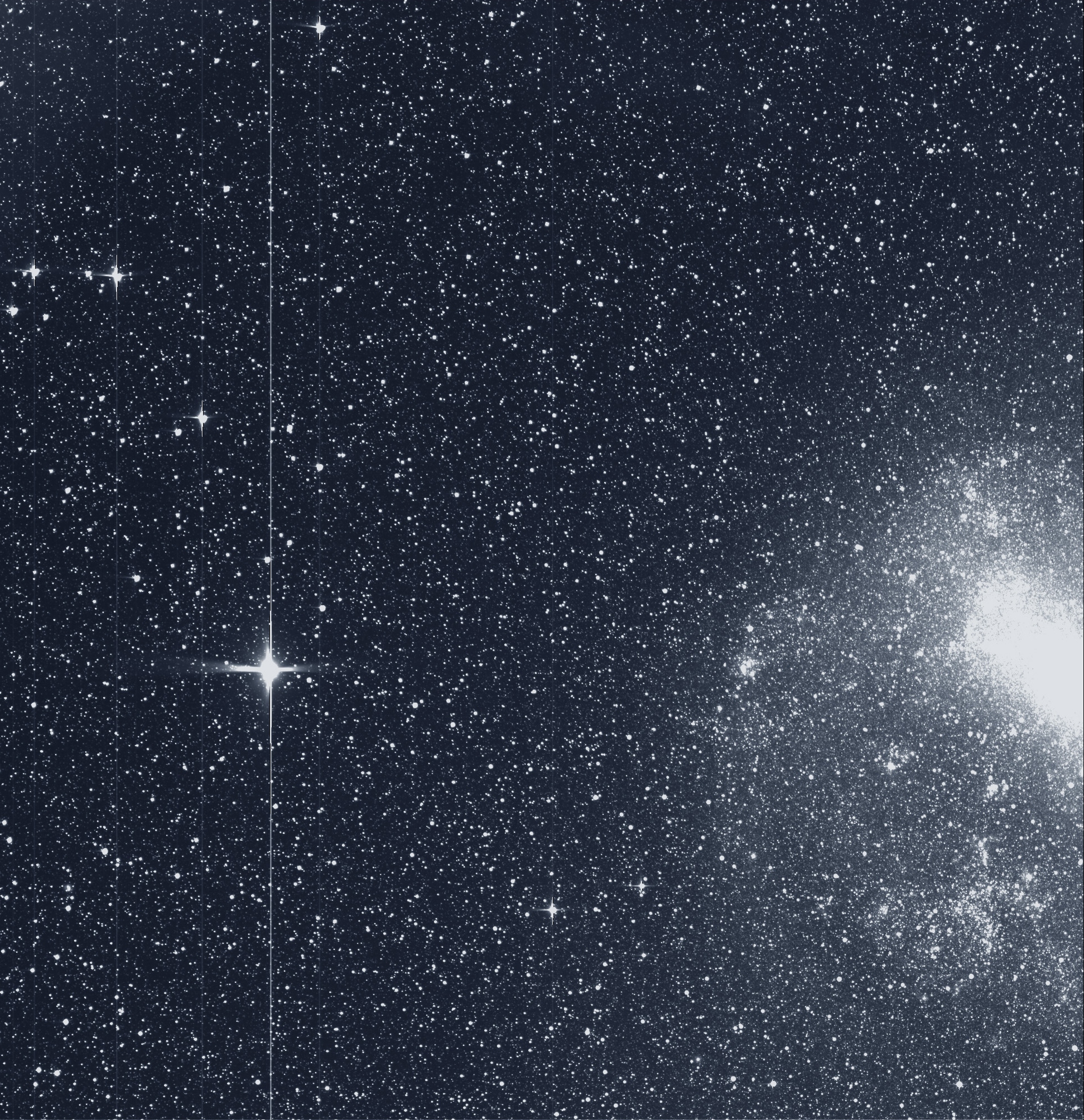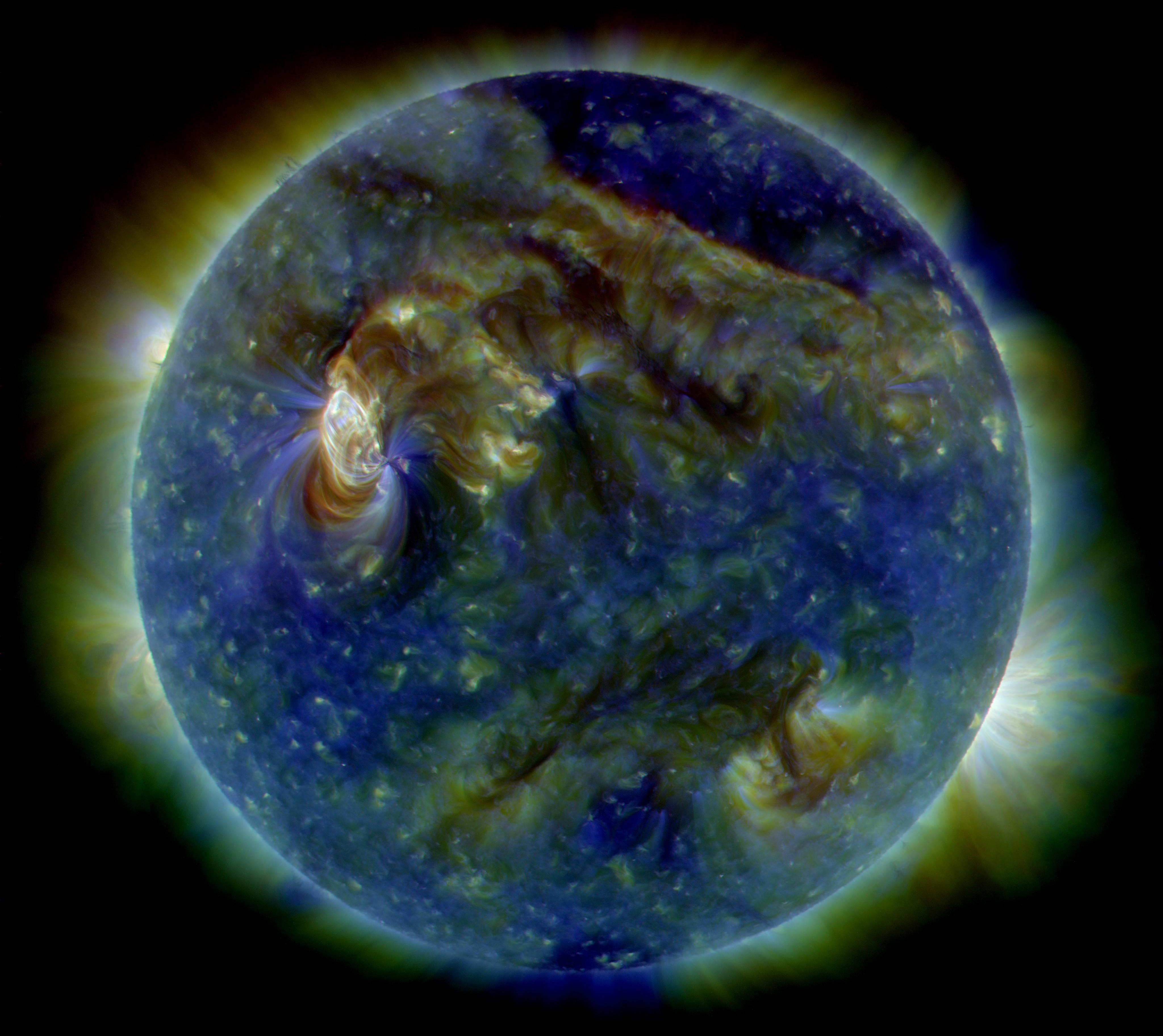|
TOI-700
TOI-700 is a red dwarf 101.4 light-years away from Earth located in the Dorado constellation that hosts TOI-700 d, the first Earth-sized exoplanet in the habitable zone discovered by the Transiting Exoplanet Survey Satellite (TESS). Nomenclature and history The acronym "TOI" refers to stars and exoplanets studied by TESS, and is short for: "Transiting Exoplanet Survey Satellite Object of Interest". Stellar characteristics TOI-700 is a red dwarf of spectral class M (much redder, cooler, and dimmer than the sun) that is 40% the mass, 40% the radius and 55% of the temperature of the Sun. The star is bright with low levels of stellar activity. Over the 11 sectors observed with TESS, the star does not show a single white-light flare. The low rotation rate is also an indicator of low stellar activity. Planetary system Four exoplanets have been detected by TESS to be orbiting the host star TOI-700. All four exoplanets may be tidally locked to TOI-700. Three papers de ... [...More Info...] [...Related Items...] OR: [Wikipedia] [Google] [Baidu] |
TOI-700 D
TOI-700 d is a near-Earth-sized exoplanet, likely rocky, orbiting within the habitable zone of the red dwarf TOI-700, the outermost planet within the system. It is located roughly away from Earth in the constellation of Dorado. The exoplanet is the first Earth-sized exoplanet in the habitable zone discovered by the Transiting Exoplanet Survey Satellite (TESS). TOI-700 d orbits its star at a distance of from its host star with an orbital period of roughly 37.4 days, has a mass about 1.7 times that of Earth, and has a radius of around 1.19 times that of Earth. It has been estimated that the planet receives about 86% the energy that the Earth receives from the Sun. It was discovered in early January 2020 by the Transiting Exoplanet Survey Satellite (TESS). Physical characteristics Mass, radius and temperature TOI-700 d is Earth-sized, an exoplanet that has a radius and mass similar to the Earth. It has an estimated mass of around and a radius of about . If it has an earthlike ... [...More Info...] [...Related Items...] OR: [Wikipedia] [Google] [Baidu] |
Transiting Exoplanet Survey Satellite
Transiting Exoplanet Survey Satellite (TESS, Explorer 95 or MIDEX-7) is a space telescope for NASA's Explorer program, designed to search for exoplanets using the transit method in an area 400 times larger than that covered by the ''Kepler'' mission. It was launched on 18 April 2018, atop a Falcon 9 launch vehicle and was placed into a highly elliptical 13.70-day orbit around the Earth. The first light image from TESS was taken on 7 August 2018, and released publicly on 17 September 2018. Over the course of the two-year primary mission, TESS was expected to ultimately detect about 1,250 transiting exoplanets orbiting the targeted stars, and an additional 13,000 transiting planets orbiting additional stars in the fields that TESS would observe. As of 5 November 2022, TESS had identified 5,969 candidate exoplanets, of which only 268 had been confirmed and 1720 had been dismissed as false positives. After the end of the primary mission around 4 July 2020, data from the primar ... [...More Info...] [...Related Items...] OR: [Wikipedia] [Google] [Baidu] |
Spitzer Space Telescope
The Spitzer Space Telescope, formerly the Space Infrared Telescope Facility (SIRTF), was an infrared space telescope launched in 2003. Operations ended on 30 January 2020. Spitzer was the third space telescope dedicated to infrared astronomy, following IRAS (1983) and ISO (1995–1998). It was the first spacecraft to use an Earth-trailing orbit, later used by the Kepler planet-finder. The planned mission period was to be 2.5 years with a pre-launch expectation that the mission could extend to five or slightly more years until the onboard liquid helium supply was exhausted. This occurred on 15 May 2009. Without liquid helium to cool the telescope to the very low temperatures needed to operate, most of the instruments were no longer usable. However, the two shortest-wavelength modules of the IRAC camera continued to operate with the same sensitivity as before the helium was exhausted, and continued to be used into early 2020 in the Spitzer Warm Mission. During the warm mission, t ... [...More Info...] [...Related Items...] OR: [Wikipedia] [Google] [Baidu] |
Kepler-62f
Kepler-62f (also known by its Kepler Object of Interest designation ''KOI-701.04'') is a super-Earth exoplanet orbiting within the habitable zone of the star Kepler-62, the outermost of five such planets discovered around the star by NASA's ''Kepler'' spacecraft. It is located about 990 light-years (304 parsecs) from Earth in the constellation of Lyra. Kepler-62f orbits its star at a distance of from its host star with an orbital period of roughly 267.3 days, has a mass at least 2.8x times that of Earth, and has a radius of around 1.41 times that of Earth. It is one of the more promising candidates for potential habitability, as its parent star is a relatively quiet star, and has less mass than the Sun – thus it can live up to a span of about 30 billion years or so. Due to its mass, Kepler-62f is likely a terrestrial or ocean-covered planet. However, key components of the exoplanet still need to be assessed to determine habitability; such as its atmosphere if one exists, sin ... [...More Info...] [...Related Items...] OR: [Wikipedia] [Google] [Baidu] |
TESS Mission's First Earth-size World In Star's Habitable-zone
Tess or TESS may refer to: Music * Tess (band), a Spanish pop band active from 2000 to 2005 * TESS (musician), a UK musician Film and theatre * ''Tess'' (1979 film), a 1979 film adaptation of '' Tess of the d'Urbervilles'' * ''Tess'' (2016 film), a South African production * ''Tess'' (play), a stage adaptation of ''Tess of the d'Urbervilles'' featuring Tanya Franks Science and technology * Trademark Electronic Search System, a service of the U.S. Patent and Trademark Office * Transiting Exoplanet Survey Satellite, a space telescope designed to search for extra-solar planets * Ethinylestradiol/cyproterone acetate, a birth control pill * Typhoon Tess (other) Other uses * Tess (given name) * Nikolay Tess Nikolay Tess ( lv, Nikolajs Tess, russian: Николай Тэсс; 1921 – December 7, 2006 in Riga, Latvia) was one of the few functionaries in charge of political repressions in the former Soviet Union who were convicted for this activity. Ni ... (1921–2006), me ... [...More Info...] [...Related Items...] OR: [Wikipedia] [Google] [Baidu] |
NASA
The National Aeronautics and Space Administration (NASA ) is an independent agency of the US federal government responsible for the civil space program, aeronautics research, and space research. NASA was established in 1958, succeeding the National Advisory Committee for Aeronautics (NACA), to give the U.S. space development effort a distinctly civilian orientation, emphasizing peaceful applications in space science. NASA has since led most American space exploration, including Project Mercury, Project Gemini, the 1968-1972 Apollo Moon landing missions, the Skylab space station, and the Space Shuttle. NASA supports the International Space Station and oversees the development of the Orion spacecraft and the Space Launch System for the crewed lunar Artemis program, Commercial Crew spacecraft, and the planned Lunar Gateway space station. The agency is also responsible for the Launch Services Program, which provides oversight of launch operations and countdown management f ... [...More Info...] [...Related Items...] OR: [Wikipedia] [Google] [Baidu] |
James Webb Space Telescope
The James Webb Space Telescope (JWST) is a space telescope which conducts infrared astronomy. As the largest optical telescope in space, its high resolution and sensitivity allow it to view objects too old, distant, or faint for the Hubble Space Telescope. This will enable investigations across many fields of astronomy and cosmology, such as observation of the first stars, the formation of the first galaxies, and detailed atmospheric characterization of potentially habitable exoplanets. The U.S. National Aeronautics and Space Administration (NASA) led JWST's design and development and partnered with two main agencies: the European Space Agency (ESA) and the Canadian Space Agency (CSA). The NASA Goddard Space Flight Center (GSFC) in Maryland managed telescope development, the Space Telescope Science Institute in Baltimore on the Homewood Campus of Johns Hopkins University operates JWST, and the prime contractor was Northrop Grumman. The telescope is named after James E. Webb, ... [...More Info...] [...Related Items...] OR: [Wikipedia] [Google] [Baidu] |
Parts Per Million
In science and engineering, the parts-per notation is a set of pseudo-units to describe small values of miscellaneous dimensionless quantities, e.g. mole fraction or mass fraction. Since these fractions are quantity-per-quantity measures, they are pure numbers with no associated units of measurement. Commonly used are parts-per-million (ppm, ), parts-per-billion (ppb, ), parts-per-trillion (ppt, ) and parts-per-quadrillion (ppq, ). This notation is not part of the International System of Units (SI) system and its meaning is ambiguous. Overview Parts-per notation is often used describing dilute solutions in chemistry, for instance, the relative abundance of dissolved minerals or pollutants in water. The quantity "1 ppm" can be used for a mass fraction if a water-borne pollutant is present at one-millionth of a gram per gram of sample solution. When working with aqueous solutions, it is common to assume that the density of water is 1.00 g/mL. Therefore, it is common to equat ... [...More Info...] [...Related Items...] OR: [Wikipedia] [Google] [Baidu] |
Billion Years
A billion years or giga-annum (109 years) is a unit of time on the petasecond scale, more precisely equal to seconds (or simply 1,000,000,000 years). It is sometimes abbreviated Gy, Ga ("giga-annum"), Byr and variants. The abbreviations Gya or bya are for "billion years ago", i.e. billion years before present. The terms are used in geology, paleontology, geophysics, astronomy, and physical cosmology. The prefix giga- is preferred to billion- to avoid confusion in the long and short scales over the meaning of billion; the postfix annum may be further qualified for precision as a sidereal year or Julian year: :1 Gaj = s, :1 Gas = s (epoch J2000.0). :1 Gas = y Byr was formerly used in English-language geology and astronomy as a unit of one billion years. Subsequently, the term gigaannum (Ga) has increased in usage, with Gy or Gyr still sometimes used in English-language works (at the risk of confusion with Gy as abbreviation for the gray, a ... [...More Info...] [...Related Items...] OR: [Wikipedia] [Google] [Baidu] |
TRAPPIST-1 E
TRAPPIST-1e, also designated as 2MASS J23062928-0502285 e, is a rocky, close-to-Earth-sized exoplanet orbiting within the habitable zone around the ultracool dwarf star TRAPPIST-1 approximately away from Earth in the constellation of Aquarius. Astronomers found the exoplanet by using the transit method, in which the dimming effect that a planet causes as it crosses in front of its star is measured. The exoplanet was one of seven new exoplanets discovered orbiting the star using observations from the Spitzer Space Telescope. Three of the seven (''e'', ''f'', and ''g'') are in the habitable zone. TRAPPIST-1e is similar to Earth's mass, radius, density, gravity, temperature, and stellar flux. It is also confirmed to not have a cloud-free hydrogen-dominated atmosphere, meaning it is more likely to have a compact atmosphere like the terrestrial planets in our solar system. In November 2018, researchers determined that of the seven exoplanets in the multi-planetary system, ... [...More Info...] [...Related Items...] OR: [Wikipedia] [Google] [Baidu] |
Extreme Ultraviolet
Extreme ultraviolet radiation (EUV or XUV) or high-energy ultraviolet radiation is electromagnetic radiation in the part of the electromagnetic spectrum spanning wavelengths from 124 nm down to 10 nm, and therefore (by the Planck–Einstein equation) having photons with energies from 10 eV up to 124 eV. EUV is naturally generated by the solar corona and artificially by plasma, high harmonic generation sources and synchrotron light sources. Since UVC extends to 100 nm, there is some overlap in the terms. The main uses of extreme ultraviolet radiation are photoelectron spectroscopy, solar imaging, and lithography. In air, EUV is the most highly absorbed component of the electromagnetic spectrum, requiring high vacuum for transmission. EUV generation Neutral atoms or condensed matter cannot emit EUV radiation. Ionization must take place first. EUV light can only be emitted by electrons which are bound to multicharged positive ions; for example, t ... [...More Info...] [...Related Items...] OR: [Wikipedia] [Google] [Baidu] |





.jpg)


